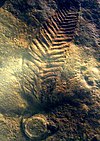Thaumaptilon
| Thaumaptilon Temporal range: | |
|---|---|

| |
| Holotype | |
| Scientific classification | |
| Kingdom: | |
| Genus: | Thaumaptilon Conway Morris, 1993 |
| Species: | T. walcotti |
Thaumaptilon is a fossil genus of animals from the middle Cambrian Burgess Shale which some authors have compared to members of the Ediacaran biota, generally believed to have disappeared at the start of the Cambrian, 539 million years ago.[1] It was up to 20 cm long, and attached itself to the sea floor with a holdfast.
Leaf-shaped, Thaumaptilon had a central axis extending to its tip, with many "ribs" radiating from it, in a similar manner to the ribs of a leaf. These may have had canals connecting them to the axis. One side of its surface was covered in spots, which might have been zooids.
Thaumaptilon is considered important due to its resemblance to some frondose Ediacarans; it was believed to be a relative of forms such as Charnia.[2][3][4] A 2020 study suggested that it should be placed in the group Petalonamae along with similar Ediacaran forms.[5]
Forms related to Charnia were once believed to be related to sea-pens (pennatulacean cnidarians), although this hypothesis has been questioned based on several lines of evidence.[6][7]
The name Thaumaptilon is said to be derived from the Greek thauma, "wonderful", + ptilon, "soft feather".[2] In ancient Greek, thauma (θαῦμα) however means "wonder".[8]
See also
References
- ^ "Stratigraphic Chart 2022" (PDF). International Stratigraphic Commission. February 2022. Retrieved 25 April 2022.
- ^ a b Conway Morris, S. (1993). "Ediacaran-like fossils in Cambrian Burgess Shale-type faunas of North America" (PDF). Palaeontology. 36 (3): 593–635. Archived from the original (PDF) on 2012-03-09.
- ^ Crimes, T. P.; McIlroy, D. (1999). "A biota of Ediacaran aspect from lower Cambrian strata on the Digermul Peninsula, Arctic Norway". Geological Magazine. 136 (6): 633. Bibcode:1999GeoM..136..633C. doi:10.1017/S0016756899003179. S2CID 129104459.
- ^ Jensen, S. R.; Gehling, J. G.; Droser, M. L. (1998). "Ediacara-type fossils in Cambrian sediments". Nature. 393 (6685): 567. Bibcode:1998Natur.393..567J. doi:10.1038/31215. S2CID 205001064.
- ^ Hoyal Cuthill, Jennifer F (July 2022). "Ediacaran survivors in the Cambrian: suspicions, denials and a smoking gun". Geological Magazine. 159 (7): 1210–1219. doi:10.1017/S0016756821001333. ISSN 0016-7568.
- ^ Williams, G.C. 1997. Preliminary assessment of the phylogenetics of pennatulacean octocorals, with a reevaluation of Ediacaran frond-like fossils, and a synthesis of the history of evolutionary thought regarding the sea pens. Proceedings of the Sixth International Conference of Coelenterate Biology: 497-509.
- ^ Antcliffe, J. B.; Brasier, M. D. (2007). "Charnia and sea pens are poles apart". Journal of the Geological Society. 164 (1): 49–51. Bibcode:2007JGSoc.164...49A. doi:10.1144/0016-76492006-080. S2CID 130602154.
- ^ Liddell, H.G. & Scott, R. (1940). A Greek-English Lexicon. revised and augmented throughout by Sir Henry Stuart Jones. with the assistance of. Roderick McKenzie. Oxford: Clarendon Press.
External links
- "Thaumaptilon walcotti". Burgess Shale Fossil Gallery. Virtual Museum of Canada. 2011. Archived from the original on 2020-11-12.
- http://paleobiology.si.edu/burgess/thaumaptilon.html

